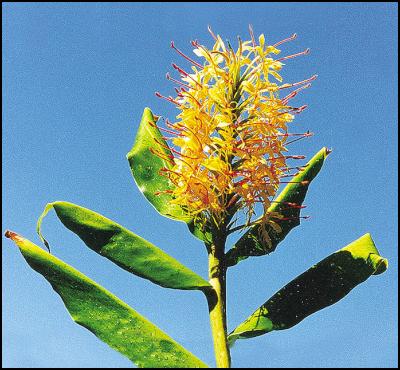Wild Ginger a threat to native bush
Thursday 27 July 2005
Wild Ginger a threat
to important coastal native bush

A single, rampant weed is threatening the biodiversity of native forests on the Bay of Plenty’s east coast.
A recent survey by Environment Bay of Plenty has found Kahili ginger growing wild over more than 600ha, and on 250 properties, between Torere and Whangaparaoa.
Pest plant coordinator John Mather says the infestations “seriously compromise” the high biodiversity and landscape values of the area, which hosts the largest tracts of coastal native forest in the North Island. “It poses possibly the greatest environmental threat to the coast,” Mr Mather says. “Without intervention, the situation will eventually become unmanageable.”
Wild ginger had steadily spread from original plantings along the coast to deep inside the bush. “The result, which is already clearly visible in some places, is a forest canopy with an understorey of pure ginger. This destruction of the natural process will eventually lead to the complete collapse of parts of the forest as old trees naturally die.”
Wild ginger is a Progressive Control Pest Plant in Environment Bay of Plenty’s Regional Pest Management Strategy. This means landowners or occupiers must control infestations on their properties. However, Mr Mather says the regulation is difficult to enforce because of fragmented land ownership and a small population base.
“We have a very small number of people pitted against a large area of wild ginger.” Individuals and voluntary groups, including marae committee and care groups, are making a “valiant effort”. “Everyone is genuinely concerned but equally genuinely unable to muster the manpower and resources to deal with such a large problem.”
Mr Mather says, for the future of biodiversity on the coast, control of the pest plant is critical. He will be presenting options for the task to the regional council’s next operational services committee meeting in early September.
Kahili ginger is a native of the Himalayan foothills and has been cultivated in New Zealand gardens since 1865. It was originally prized in gardens because of its spectacular flowers and strong scent. And it is very easy to grow - a single plant will spread to densely cover an area of many square metres. It is also spread further afield by birds which eat the small fruit, leaving the seeds in their droppings.
ENDS


 Gordon Campbell: On unemployment, Winston Peters’ low boiling point and music criticism
Gordon Campbell: On unemployment, Winston Peters’ low boiling point and music criticism Labour Party: National Gaslights Women Fighting For Equal Pay
Labour Party: National Gaslights Women Fighting For Equal Pay The Treasury: New Treasury Paper On The Productivity Slowdown
The Treasury: New Treasury Paper On The Productivity Slowdown NZ Government: Government Recommits To Equal Pay
NZ Government: Government Recommits To Equal Pay Emily Ireland - Local Democracy Reporter: Deputy Mayor ‘disgusted’ By Response To Georgina Beyer Sculpture
Emily Ireland - Local Democracy Reporter: Deputy Mayor ‘disgusted’ By Response To Georgina Beyer Sculpture Te Pāti Māori: Māori Unemployment Rate Increases By More Than Four-Times National Rates
Te Pāti Māori: Māori Unemployment Rate Increases By More Than Four-Times National Rates Government: Streamlining Building Consent Changes
Government: Streamlining Building Consent Changes


